Corporate Finance: Multi-Chem and TWC Project Analysis Report
VerifiedAdded on 2022/12/28
|14
|1916
|84
Report
AI Summary
This report presents a comprehensive analysis of two corporate finance projects: Multi-Chem and Tome win Water Company (TWC). The Multi-Chem section evaluates two potential projects using Net Present Value (NPV), Internal Rate of Return (IRR), and payback period to determine the most viable in...
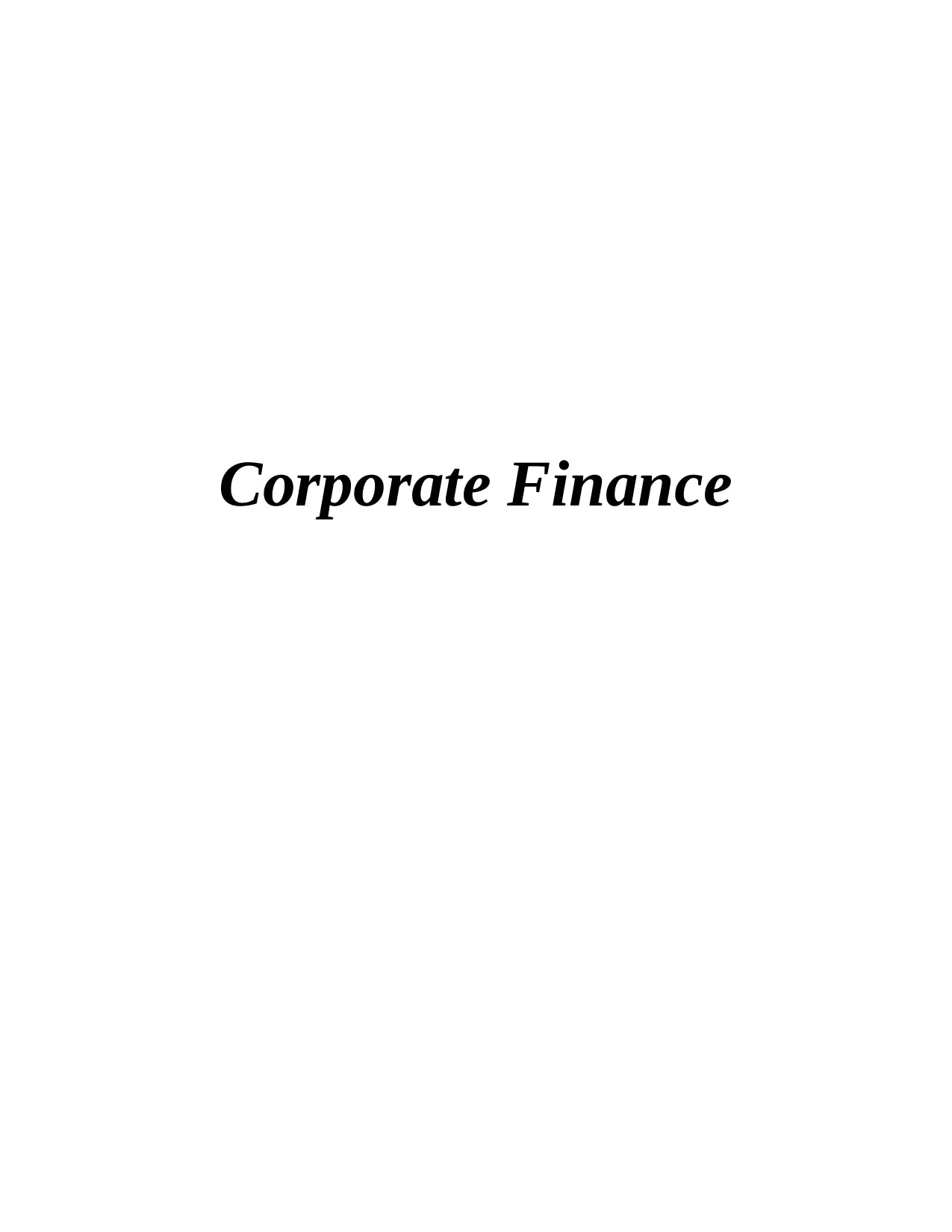
Corporate Finance
Paraphrase This Document
Need a fresh take? Get an instant paraphrase of this document with our AI Paraphraser

Table of Contents
INTRODUCTION...........................................................................................................................1
TASK 1............................................................................................................................................1
Multi-chem..................................................................................................................................1
TASK 2............................................................................................................................................3
Tome win Water Company.........................................................................................................3
1. Recommendation on the appropriate discount rate to be used in the appraisal of the new
project:.........................................................................................................................................3
2. Forecasting risk of this project:...............................................................................................4
Scenario analysis on the following two scenarios:.....................................................................8
3...................................................................................................................................................9
CONCLUSION................................................................................................................................9
REFERENCES..............................................................................................................................10
INTRODUCTION...........................................................................................................................1
TASK 1............................................................................................................................................1
Multi-chem..................................................................................................................................1
TASK 2............................................................................................................................................3
Tome win Water Company.........................................................................................................3
1. Recommendation on the appropriate discount rate to be used in the appraisal of the new
project:.........................................................................................................................................3
2. Forecasting risk of this project:...............................................................................................4
Scenario analysis on the following two scenarios:.....................................................................8
3...................................................................................................................................................9
CONCLUSION................................................................................................................................9
REFERENCES..............................................................................................................................10
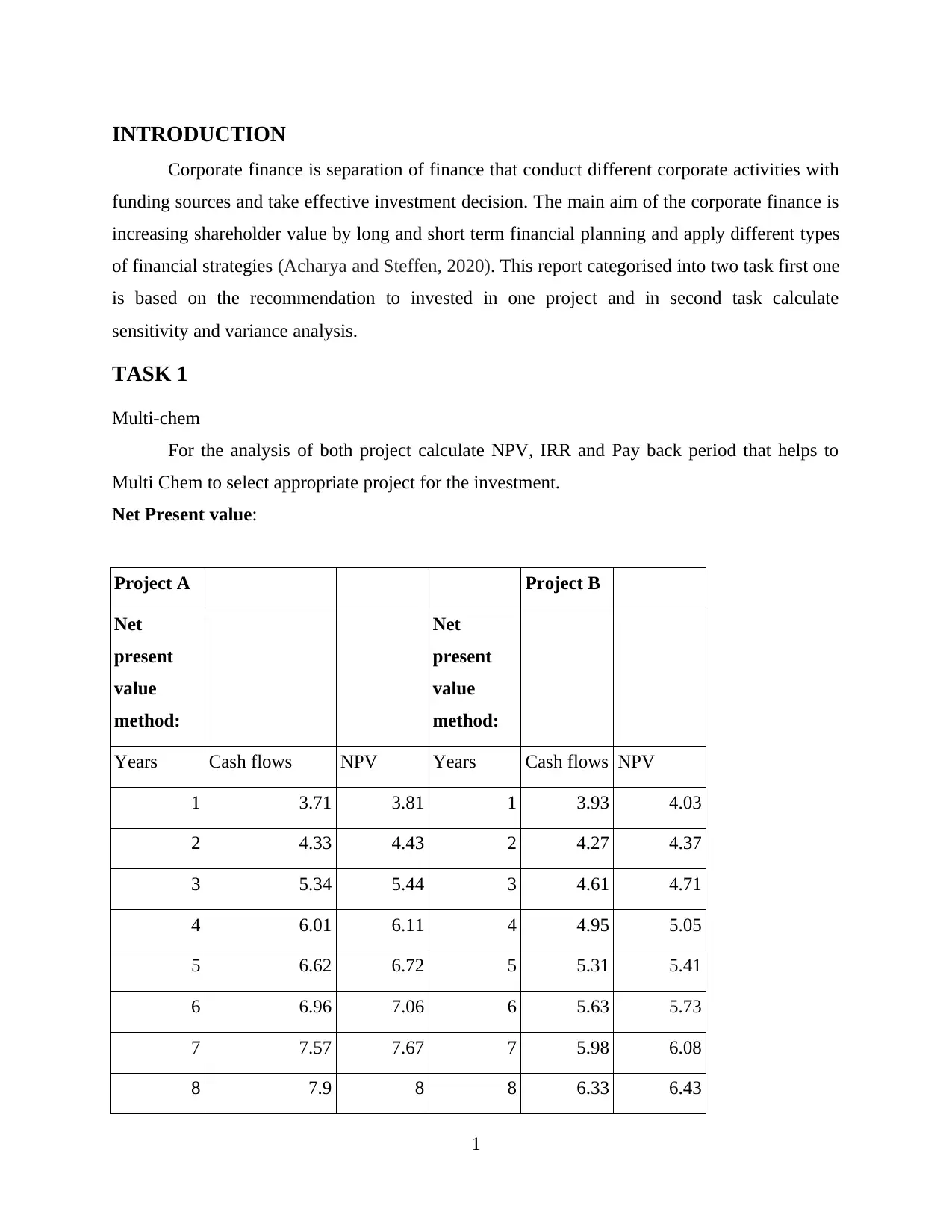
INTRODUCTION
Corporate finance is separation of finance that conduct different corporate activities with
funding sources and take effective investment decision. The main aim of the corporate finance is
increasing shareholder value by long and short term financial planning and apply different types
of financial strategies (Acharya and Steffen, 2020). This report categorised into two task first one
is based on the recommendation to invested in one project and in second task calculate
sensitivity and variance analysis.
TASK 1
Multi-chem
For the analysis of both project calculate NPV, IRR and Pay back period that helps to
Multi Chem to select appropriate project for the investment.
Net Present value:
Project A Project B
Net
present
value
method:
Net
present
value
method:
Years Cash flows NPV Years Cash flows NPV
1 3.71 3.81 1 3.93 4.03
2 4.33 4.43 2 4.27 4.37
3 5.34 5.44 3 4.61 4.71
4 6.01 6.11 4 4.95 5.05
5 6.62 6.72 5 5.31 5.41
6 6.96 7.06 6 5.63 5.73
7 7.57 7.67 7 5.98 6.08
8 7.9 8 8 6.33 6.43
1
Corporate finance is separation of finance that conduct different corporate activities with
funding sources and take effective investment decision. The main aim of the corporate finance is
increasing shareholder value by long and short term financial planning and apply different types
of financial strategies (Acharya and Steffen, 2020). This report categorised into two task first one
is based on the recommendation to invested in one project and in second task calculate
sensitivity and variance analysis.
TASK 1
Multi-chem
For the analysis of both project calculate NPV, IRR and Pay back period that helps to
Multi Chem to select appropriate project for the investment.
Net Present value:
Project A Project B
Net
present
value
method:
Net
present
value
method:
Years Cash flows NPV Years Cash flows NPV
1 3.71 3.81 1 3.93 4.03
2 4.33 4.43 2 4.27 4.37
3 5.34 5.44 3 4.61 4.71
4 6.01 6.11 4 4.95 5.05
5 6.62 6.72 5 5.31 5.41
6 6.96 7.06 6 5.63 5.73
7 7.57 7.67 7 5.98 6.08
8 7.9 8 8 6.33 6.43
1
⊘ This is a preview!⊘
Do you want full access?
Subscribe today to unlock all pages.

Trusted by 1+ million students worldwide

9 8.31 8.41 9 6.95 7.05
10 8.9 9 10 7.36 7.46
66.65 56.32
Net present
value = Cash
inflow – cash
outflow
45.1 36.32
Project A is
beneficial for
the Manila
plant.
Pay Back period:
Project
A
Project
B
Payback
period
method:
Payback
method
Purchase for land $2.55 million $15
Development and construction building
costs of $13 million $5
plant and equipment of $6 million
Sales $48.6 million, increasing 10% 45
Costs for goods sold 65% 75.00%
Fixed costs $11.5 million, increasing 5% 5, 5%
2
10 8.9 9 10 7.36 7.46
66.65 56.32
Net present
value = Cash
inflow – cash
outflow
45.1 36.32
Project A is
beneficial for
the Manila
plant.
Pay Back period:
Project
A
Project
B
Payback
period
method:
Payback
method
Purchase for land $2.55 million $15
Development and construction building
costs of $13 million $5
plant and equipment of $6 million
Sales $48.6 million, increasing 10% 45
Costs for goods sold 65% 75.00%
Fixed costs $11.5 million, increasing 5% 5, 5%
2
Paraphrase This Document
Need a fresh take? Get an instant paraphrase of this document with our AI Paraphraser
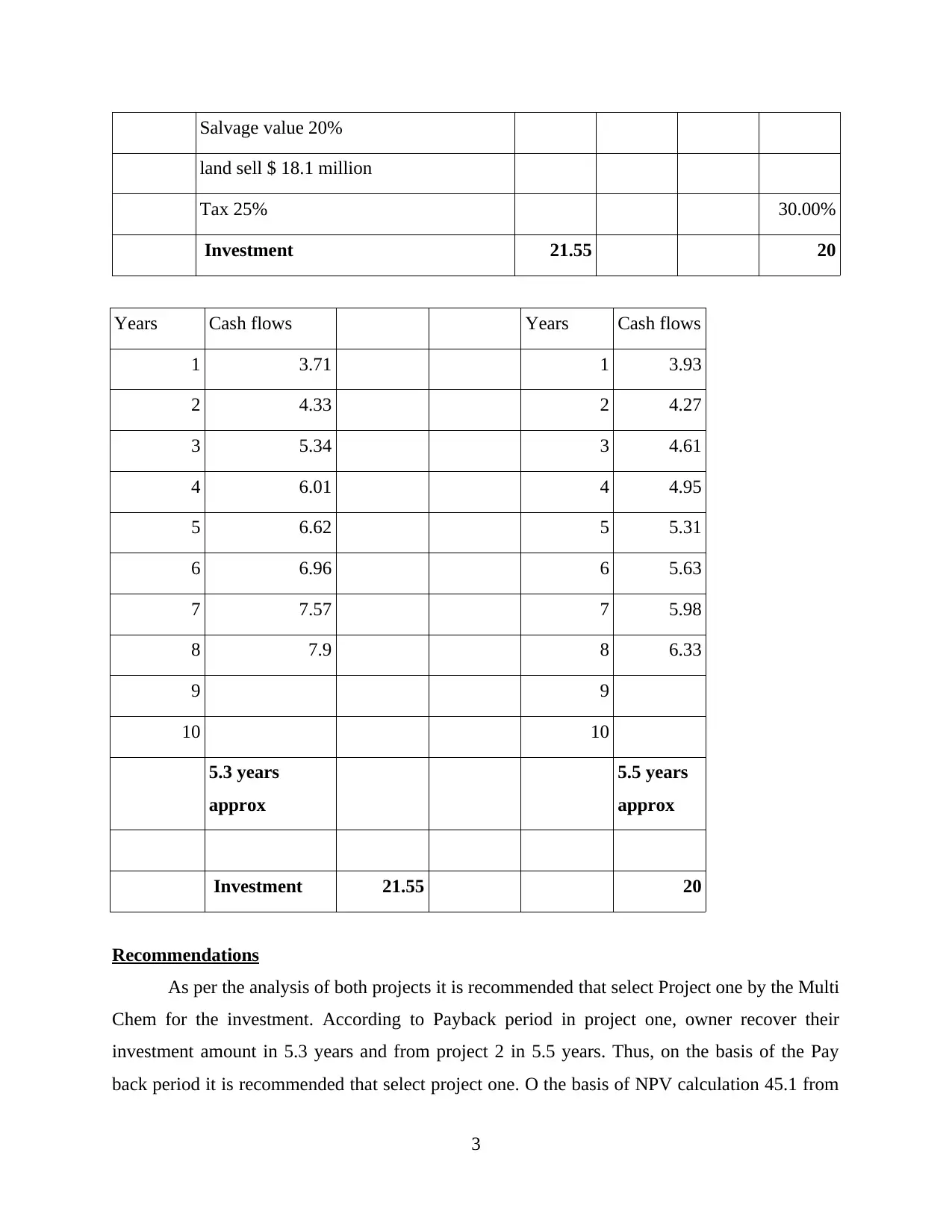
Salvage value 20%
land sell $ 18.1 million
Tax 25% 30.00%
Investment 21.55 20
Years Cash flows Years Cash flows
1 3.71 1 3.93
2 4.33 2 4.27
3 5.34 3 4.61
4 6.01 4 4.95
5 6.62 5 5.31
6 6.96 6 5.63
7 7.57 7 5.98
8 7.9 8 6.33
9 9
10 10
5.3 years
approx
5.5 years
approx
Investment 21.55 20
Recommendations
As per the analysis of both projects it is recommended that select Project one by the Multi
Chem for the investment. According to Payback period in project one, owner recover their
investment amount in 5.3 years and from project 2 in 5.5 years. Thus, on the basis of the Pay
back period it is recommended that select project one. O the basis of NPV calculation 45.1 from
3
land sell $ 18.1 million
Tax 25% 30.00%
Investment 21.55 20
Years Cash flows Years Cash flows
1 3.71 1 3.93
2 4.33 2 4.27
3 5.34 3 4.61
4 6.01 4 4.95
5 6.62 5 5.31
6 6.96 6 5.63
7 7.57 7 5.98
8 7.9 8 6.33
9 9
10 10
5.3 years
approx
5.5 years
approx
Investment 21.55 20
Recommendations
As per the analysis of both projects it is recommended that select Project one by the Multi
Chem for the investment. According to Payback period in project one, owner recover their
investment amount in 5.3 years and from project 2 in 5.5 years. Thus, on the basis of the Pay
back period it is recommended that select project one. O the basis of NPV calculation 45.1 from
3
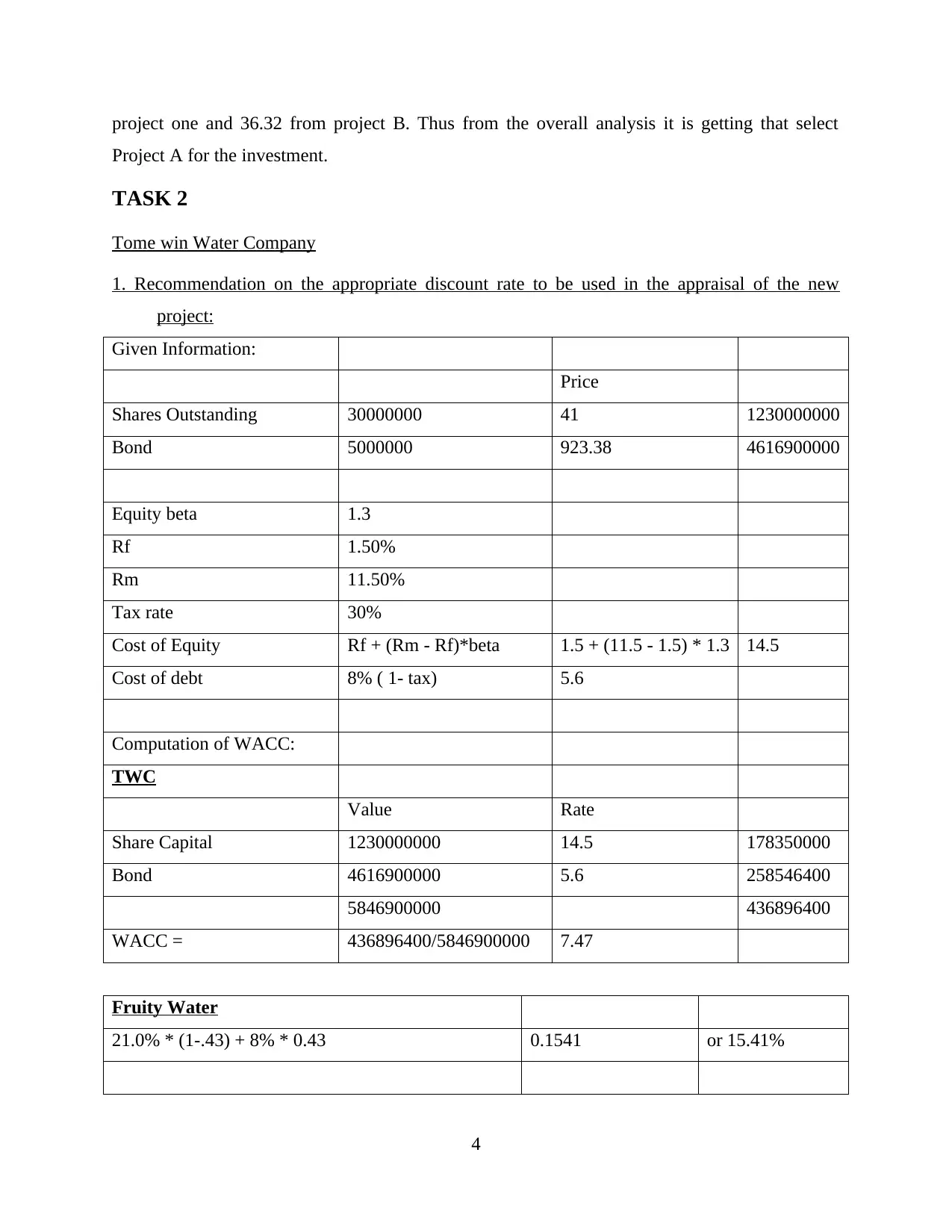
project one and 36.32 from project B. Thus from the overall analysis it is getting that select
Project A for the investment.
TASK 2
Tome win Water Company
1. Recommendation on the appropriate discount rate to be used in the appraisal of the new
project:
Given Information:
Price
Shares Outstanding 30000000 41 1230000000
Bond 5000000 923.38 4616900000
Equity beta 1.3
Rf 1.50%
Rm 11.50%
Tax rate 30%
Cost of Equity Rf + (Rm - Rf)*beta 1.5 + (11.5 - 1.5) * 1.3 14.5
Cost of debt 8% ( 1- tax) 5.6
Computation of WACC:
TWC
Value Rate
Share Capital 1230000000 14.5 178350000
Bond 4616900000 5.6 258546400
5846900000 436896400
WACC = 436896400/5846900000 7.47
Fruity Water
21.0% * (1-.43) + 8% * 0.43 0.1541 or 15.41%
4
Project A for the investment.
TASK 2
Tome win Water Company
1. Recommendation on the appropriate discount rate to be used in the appraisal of the new
project:
Given Information:
Price
Shares Outstanding 30000000 41 1230000000
Bond 5000000 923.38 4616900000
Equity beta 1.3
Rf 1.50%
Rm 11.50%
Tax rate 30%
Cost of Equity Rf + (Rm - Rf)*beta 1.5 + (11.5 - 1.5) * 1.3 14.5
Cost of debt 8% ( 1- tax) 5.6
Computation of WACC:
TWC
Value Rate
Share Capital 1230000000 14.5 178350000
Bond 4616900000 5.6 258546400
5846900000 436896400
WACC = 436896400/5846900000 7.47
Fruity Water
21.0% * (1-.43) + 8% * 0.43 0.1541 or 15.41%
4
⊘ This is a preview!⊘
Do you want full access?
Subscribe today to unlock all pages.

Trusted by 1+ million students worldwide

Ladybug Drinks
19.70% * (1-.35) + 7.75% * .35 0.155175 or 15.52%
Recommendation: Discount rates are based on the various factors and characteristics such as,
the marketability of shares and identify the location of project, procedure of development and
size & capability of projects owner. At the time of reports filed on SEDAR that can be used for
different directions. It is essential to assure about the project of an entity and relies on basis of
different sources of its project at the discount rate from different organisations of same scale,
step of development and with comparable characteristics (Benlemlih and Bitar, 2018).
TWC prepared reports through highly credible sources in which consisting of foreign
consultancy firm, experts and many large organisations. An organisation main aspects based on
the discount rate of project and calculate their rate of return to attract a major investor and
utilised by the entity for identification of the risks of individual project.
This has been analysed that TWC’s WACC is lower than comparable companies. A
higher WACC implies that in attempt to generate money a business spends a relatively larger
amount which means that business could be risky. While lower WACC, on other side, implies
that the organization cheaply obtains capital. Thus here it is recommended to TWC to take
WACC as discounting rate.
2. Forecasting risk of this project:
Initial Outlay 3000000
Life 3 years
SLM
salvage value nil
Sales 1250000
units @
2.15
Variable Costs 0.54
Fixed Cost 50000
Terminal Value 500000
Forecasting risk of this project:
5
19.70% * (1-.35) + 7.75% * .35 0.155175 or 15.52%
Recommendation: Discount rates are based on the various factors and characteristics such as,
the marketability of shares and identify the location of project, procedure of development and
size & capability of projects owner. At the time of reports filed on SEDAR that can be used for
different directions. It is essential to assure about the project of an entity and relies on basis of
different sources of its project at the discount rate from different organisations of same scale,
step of development and with comparable characteristics (Benlemlih and Bitar, 2018).
TWC prepared reports through highly credible sources in which consisting of foreign
consultancy firm, experts and many large organisations. An organisation main aspects based on
the discount rate of project and calculate their rate of return to attract a major investor and
utilised by the entity for identification of the risks of individual project.
This has been analysed that TWC’s WACC is lower than comparable companies. A
higher WACC implies that in attempt to generate money a business spends a relatively larger
amount which means that business could be risky. While lower WACC, on other side, implies
that the organization cheaply obtains capital. Thus here it is recommended to TWC to take
WACC as discounting rate.
2. Forecasting risk of this project:
Initial Outlay 3000000
Life 3 years
SLM
salvage value nil
Sales 1250000
units @
2.15
Variable Costs 0.54
Fixed Cost 50000
Terminal Value 500000
Forecasting risk of this project:
5
Paraphrase This Document
Need a fresh take? Get an instant paraphrase of this document with our AI Paraphraser
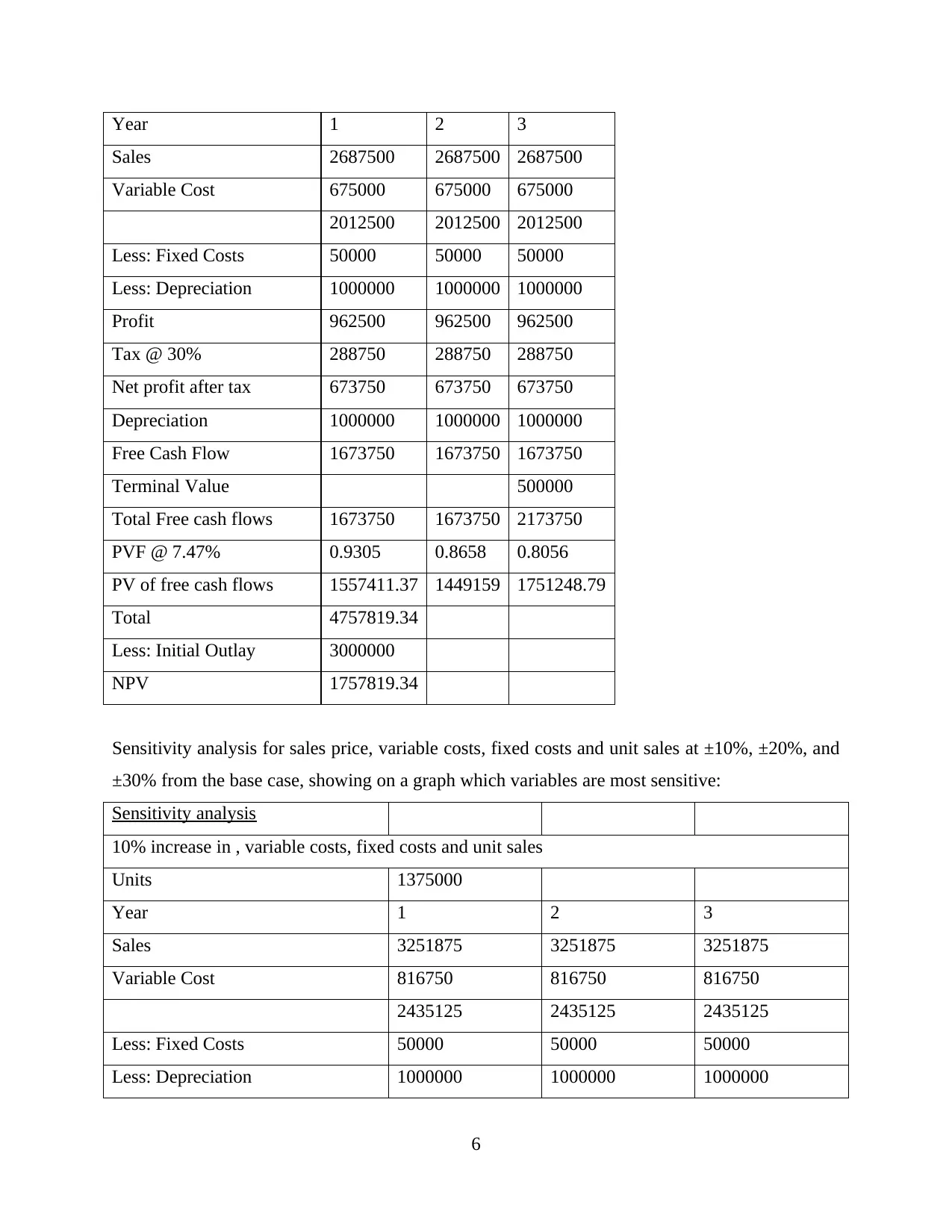
Year 1 2 3
Sales 2687500 2687500 2687500
Variable Cost 675000 675000 675000
2012500 2012500 2012500
Less: Fixed Costs 50000 50000 50000
Less: Depreciation 1000000 1000000 1000000
Profit 962500 962500 962500
Tax @ 30% 288750 288750 288750
Net profit after tax 673750 673750 673750
Depreciation 1000000 1000000 1000000
Free Cash Flow 1673750 1673750 1673750
Terminal Value 500000
Total Free cash flows 1673750 1673750 2173750
PVF @ 7.47% 0.9305 0.8658 0.8056
PV of free cash flows 1557411.37 1449159 1751248.79
Total 4757819.34
Less: Initial Outlay 3000000
NPV 1757819.34
Sensitivity analysis for sales price, variable costs, fixed costs and unit sales at ±10%, ±20%, and
±30% from the base case, showing on a graph which variables are most sensitive:
Sensitivity analysis
10% increase in , variable costs, fixed costs and unit sales
Units 1375000
Year 1 2 3
Sales 3251875 3251875 3251875
Variable Cost 816750 816750 816750
2435125 2435125 2435125
Less: Fixed Costs 50000 50000 50000
Less: Depreciation 1000000 1000000 1000000
6
Sales 2687500 2687500 2687500
Variable Cost 675000 675000 675000
2012500 2012500 2012500
Less: Fixed Costs 50000 50000 50000
Less: Depreciation 1000000 1000000 1000000
Profit 962500 962500 962500
Tax @ 30% 288750 288750 288750
Net profit after tax 673750 673750 673750
Depreciation 1000000 1000000 1000000
Free Cash Flow 1673750 1673750 1673750
Terminal Value 500000
Total Free cash flows 1673750 1673750 2173750
PVF @ 7.47% 0.9305 0.8658 0.8056
PV of free cash flows 1557411.37 1449159 1751248.79
Total 4757819.34
Less: Initial Outlay 3000000
NPV 1757819.34
Sensitivity analysis for sales price, variable costs, fixed costs and unit sales at ±10%, ±20%, and
±30% from the base case, showing on a graph which variables are most sensitive:
Sensitivity analysis
10% increase in , variable costs, fixed costs and unit sales
Units 1375000
Year 1 2 3
Sales 3251875 3251875 3251875
Variable Cost 816750 816750 816750
2435125 2435125 2435125
Less: Fixed Costs 50000 50000 50000
Less: Depreciation 1000000 1000000 1000000
6
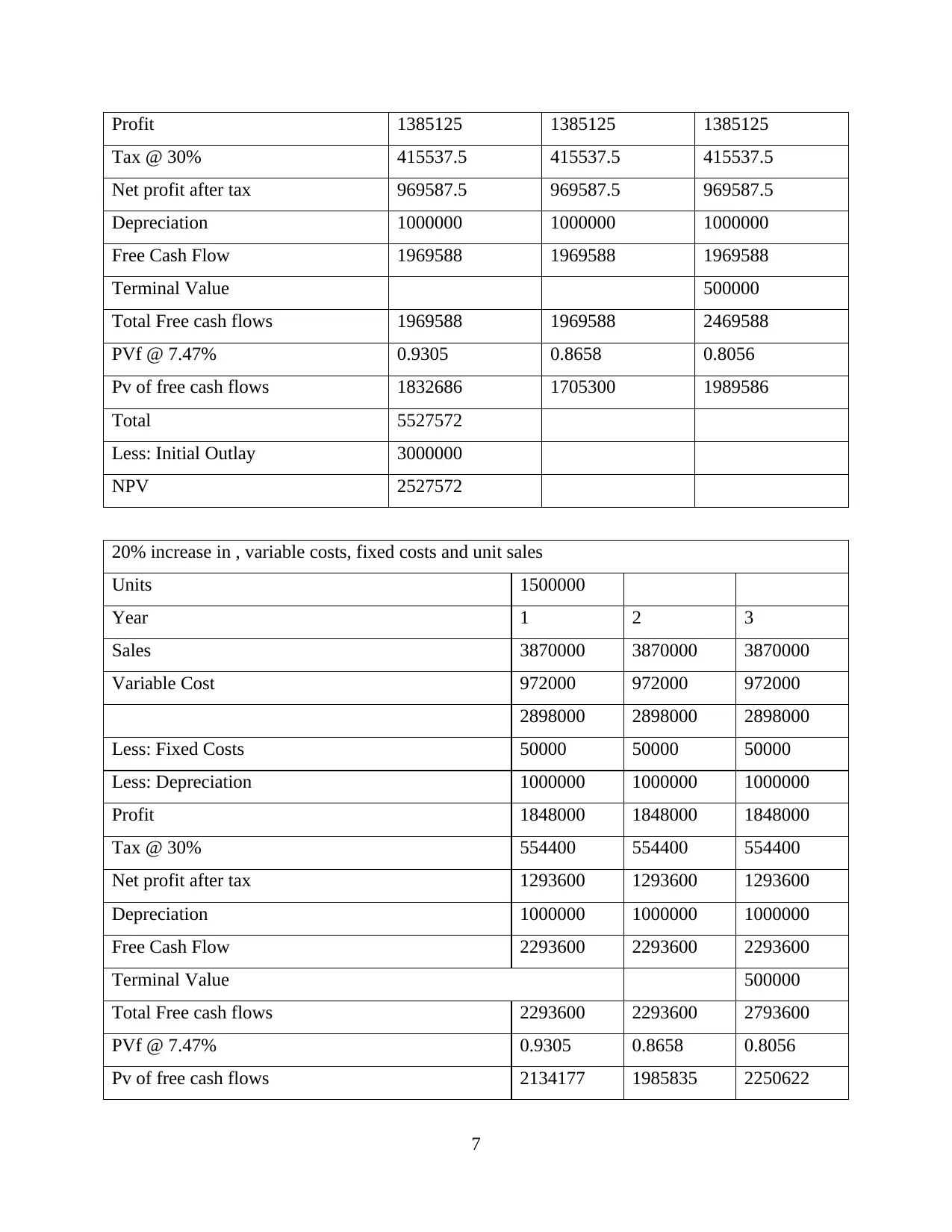
Profit 1385125 1385125 1385125
Tax @ 30% 415537.5 415537.5 415537.5
Net profit after tax 969587.5 969587.5 969587.5
Depreciation 1000000 1000000 1000000
Free Cash Flow 1969588 1969588 1969588
Terminal Value 500000
Total Free cash flows 1969588 1969588 2469588
PVf @ 7.47% 0.9305 0.8658 0.8056
Pv of free cash flows 1832686 1705300 1989586
Total 5527572
Less: Initial Outlay 3000000
NPV 2527572
20% increase in , variable costs, fixed costs and unit sales
Units 1500000
Year 1 2 3
Sales 3870000 3870000 3870000
Variable Cost 972000 972000 972000
2898000 2898000 2898000
Less: Fixed Costs 50000 50000 50000
Less: Depreciation 1000000 1000000 1000000
Profit 1848000 1848000 1848000
Tax @ 30% 554400 554400 554400
Net profit after tax 1293600 1293600 1293600
Depreciation 1000000 1000000 1000000
Free Cash Flow 2293600 2293600 2293600
Terminal Value 500000
Total Free cash flows 2293600 2293600 2793600
PVf @ 7.47% 0.9305 0.8658 0.8056
Pv of free cash flows 2134177 1985835 2250622
7
Tax @ 30% 415537.5 415537.5 415537.5
Net profit after tax 969587.5 969587.5 969587.5
Depreciation 1000000 1000000 1000000
Free Cash Flow 1969588 1969588 1969588
Terminal Value 500000
Total Free cash flows 1969588 1969588 2469588
PVf @ 7.47% 0.9305 0.8658 0.8056
Pv of free cash flows 1832686 1705300 1989586
Total 5527572
Less: Initial Outlay 3000000
NPV 2527572
20% increase in , variable costs, fixed costs and unit sales
Units 1500000
Year 1 2 3
Sales 3870000 3870000 3870000
Variable Cost 972000 972000 972000
2898000 2898000 2898000
Less: Fixed Costs 50000 50000 50000
Less: Depreciation 1000000 1000000 1000000
Profit 1848000 1848000 1848000
Tax @ 30% 554400 554400 554400
Net profit after tax 1293600 1293600 1293600
Depreciation 1000000 1000000 1000000
Free Cash Flow 2293600 2293600 2293600
Terminal Value 500000
Total Free cash flows 2293600 2293600 2793600
PVf @ 7.47% 0.9305 0.8658 0.8056
Pv of free cash flows 2134177 1985835 2250622
7
⊘ This is a preview!⊘
Do you want full access?
Subscribe today to unlock all pages.

Trusted by 1+ million students worldwide
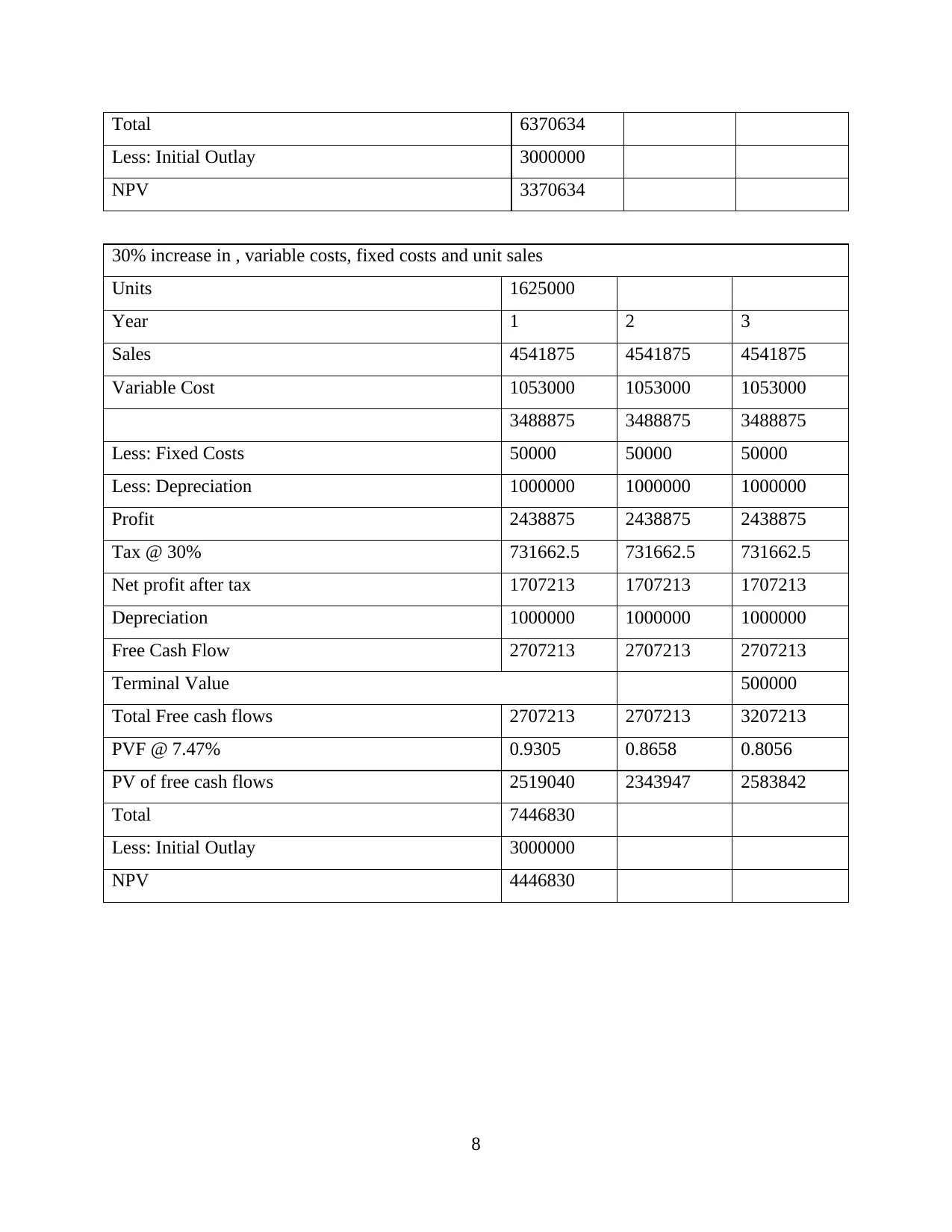
Total 6370634
Less: Initial Outlay 3000000
NPV 3370634
30% increase in , variable costs, fixed costs and unit sales
Units 1625000
Year 1 2 3
Sales 4541875 4541875 4541875
Variable Cost 1053000 1053000 1053000
3488875 3488875 3488875
Less: Fixed Costs 50000 50000 50000
Less: Depreciation 1000000 1000000 1000000
Profit 2438875 2438875 2438875
Tax @ 30% 731662.5 731662.5 731662.5
Net profit after tax 1707213 1707213 1707213
Depreciation 1000000 1000000 1000000
Free Cash Flow 2707213 2707213 2707213
Terminal Value 500000
Total Free cash flows 2707213 2707213 3207213
PVF @ 7.47% 0.9305 0.8658 0.8056
PV of free cash flows 2519040 2343947 2583842
Total 7446830
Less: Initial Outlay 3000000
NPV 4446830
8
Less: Initial Outlay 3000000
NPV 3370634
30% increase in , variable costs, fixed costs and unit sales
Units 1625000
Year 1 2 3
Sales 4541875 4541875 4541875
Variable Cost 1053000 1053000 1053000
3488875 3488875 3488875
Less: Fixed Costs 50000 50000 50000
Less: Depreciation 1000000 1000000 1000000
Profit 2438875 2438875 2438875
Tax @ 30% 731662.5 731662.5 731662.5
Net profit after tax 1707213 1707213 1707213
Depreciation 1000000 1000000 1000000
Free Cash Flow 2707213 2707213 2707213
Terminal Value 500000
Total Free cash flows 2707213 2707213 3207213
PVF @ 7.47% 0.9305 0.8658 0.8056
PV of free cash flows 2519040 2343947 2583842
Total 7446830
Less: Initial Outlay 3000000
NPV 4446830
8
Paraphrase This Document
Need a fresh take? Get an instant paraphrase of this document with our AI Paraphraser

Scenario analysis on the following two scenarios:
Scenario analysis
Worst Case: selling 1,000,000 units at a price of $1.85 and variable
cost of $0.63 per unit
Units 1000000
Year 1 2 3
Sales 1850000 1850000 1850000
Variable Cost 630000 630000 630000
1220000 1220000 1220000
Less: Fixed Costs 50000 50000 50000
Less: Depreciation 1000000 1000000 1000000
Profit 170000 170000 170000
Tax @ 30% 51000 51000 51000
Net profit after tax 119000 119000 119000
Depreciation 1000000 1000000 1000000
Free Cash Flow 1119000 1119000 1119000
Terminal Value 500000
Total Free cash flows 1119000 1119000 1619000
PVf @ 7.47% 0.9305 0.8658 0.8056
Pv of free cash flows 1041220.806 968847.9 1304323
9
Scenario analysis
Worst Case: selling 1,000,000 units at a price of $1.85 and variable
cost of $0.63 per unit
Units 1000000
Year 1 2 3
Sales 1850000 1850000 1850000
Variable Cost 630000 630000 630000
1220000 1220000 1220000
Less: Fixed Costs 50000 50000 50000
Less: Depreciation 1000000 1000000 1000000
Profit 170000 170000 170000
Tax @ 30% 51000 51000 51000
Net profit after tax 119000 119000 119000
Depreciation 1000000 1000000 1000000
Free Cash Flow 1119000 1119000 1119000
Terminal Value 500000
Total Free cash flows 1119000 1119000 1619000
PVf @ 7.47% 0.9305 0.8658 0.8056
Pv of free cash flows 1041220.806 968847.9 1304323
9
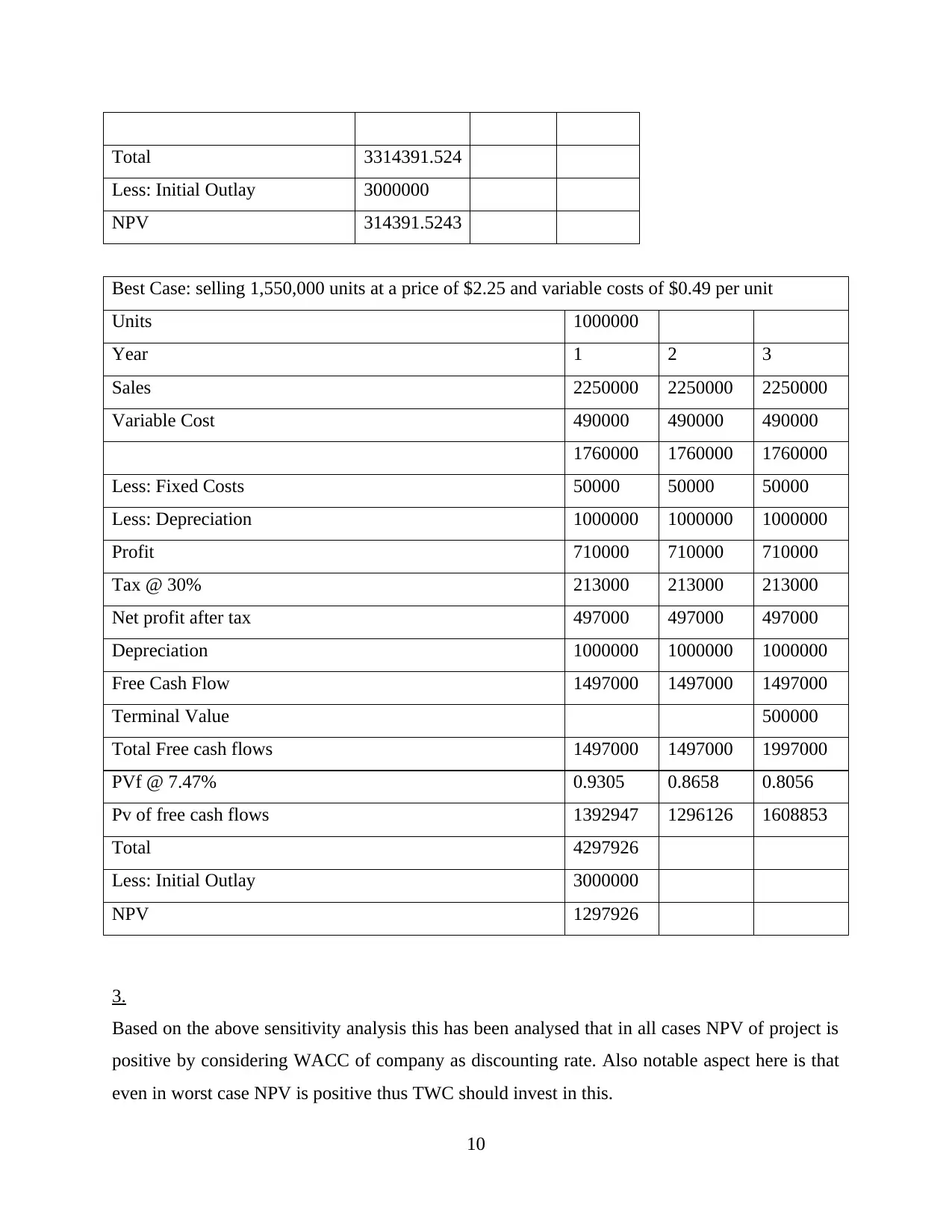
Total 3314391.524
Less: Initial Outlay 3000000
NPV 314391.5243
Best Case: selling 1,550,000 units at a price of $2.25 and variable costs of $0.49 per unit
Units 1000000
Year 1 2 3
Sales 2250000 2250000 2250000
Variable Cost 490000 490000 490000
1760000 1760000 1760000
Less: Fixed Costs 50000 50000 50000
Less: Depreciation 1000000 1000000 1000000
Profit 710000 710000 710000
Tax @ 30% 213000 213000 213000
Net profit after tax 497000 497000 497000
Depreciation 1000000 1000000 1000000
Free Cash Flow 1497000 1497000 1497000
Terminal Value 500000
Total Free cash flows 1497000 1497000 1997000
PVf @ 7.47% 0.9305 0.8658 0.8056
Pv of free cash flows 1392947 1296126 1608853
Total 4297926
Less: Initial Outlay 3000000
NPV 1297926
3.
Based on the above sensitivity analysis this has been analysed that in all cases NPV of project is
positive by considering WACC of company as discounting rate. Also notable aspect here is that
even in worst case NPV is positive thus TWC should invest in this.
10
Less: Initial Outlay 3000000
NPV 314391.5243
Best Case: selling 1,550,000 units at a price of $2.25 and variable costs of $0.49 per unit
Units 1000000
Year 1 2 3
Sales 2250000 2250000 2250000
Variable Cost 490000 490000 490000
1760000 1760000 1760000
Less: Fixed Costs 50000 50000 50000
Less: Depreciation 1000000 1000000 1000000
Profit 710000 710000 710000
Tax @ 30% 213000 213000 213000
Net profit after tax 497000 497000 497000
Depreciation 1000000 1000000 1000000
Free Cash Flow 1497000 1497000 1497000
Terminal Value 500000
Total Free cash flows 1497000 1497000 1997000
PVf @ 7.47% 0.9305 0.8658 0.8056
Pv of free cash flows 1392947 1296126 1608853
Total 4297926
Less: Initial Outlay 3000000
NPV 1297926
3.
Based on the above sensitivity analysis this has been analysed that in all cases NPV of project is
positive by considering WACC of company as discounting rate. Also notable aspect here is that
even in worst case NPV is positive thus TWC should invest in this.
10
⊘ This is a preview!⊘
Do you want full access?
Subscribe today to unlock all pages.

Trusted by 1+ million students worldwide
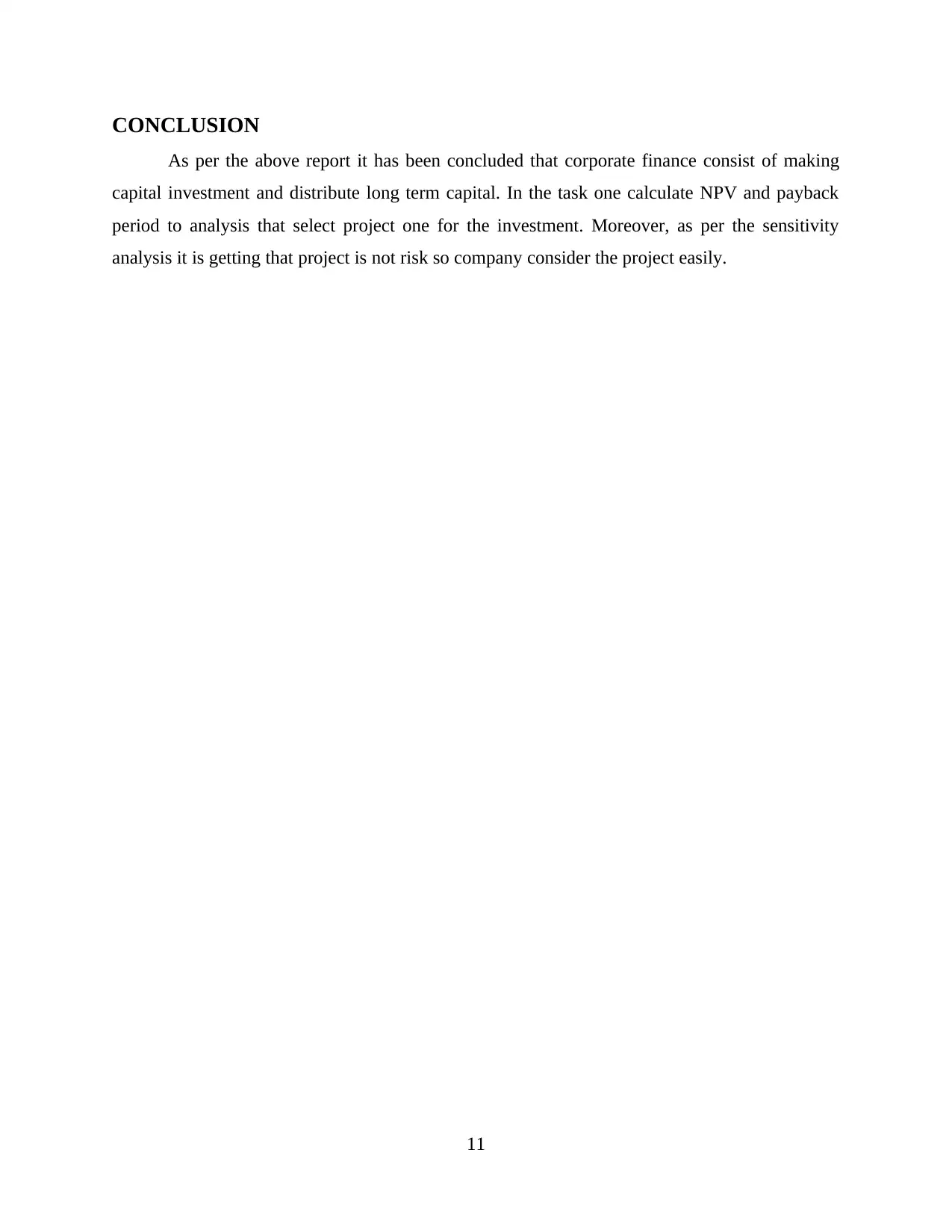
CONCLUSION
As per the above report it has been concluded that corporate finance consist of making
capital investment and distribute long term capital. In the task one calculate NPV and payback
period to analysis that select project one for the investment. Moreover, as per the sensitivity
analysis it is getting that project is not risk so company consider the project easily.
11
As per the above report it has been concluded that corporate finance consist of making
capital investment and distribute long term capital. In the task one calculate NPV and payback
period to analysis that select project one for the investment. Moreover, as per the sensitivity
analysis it is getting that project is not risk so company consider the project easily.
11
Paraphrase This Document
Need a fresh take? Get an instant paraphrase of this document with our AI Paraphraser
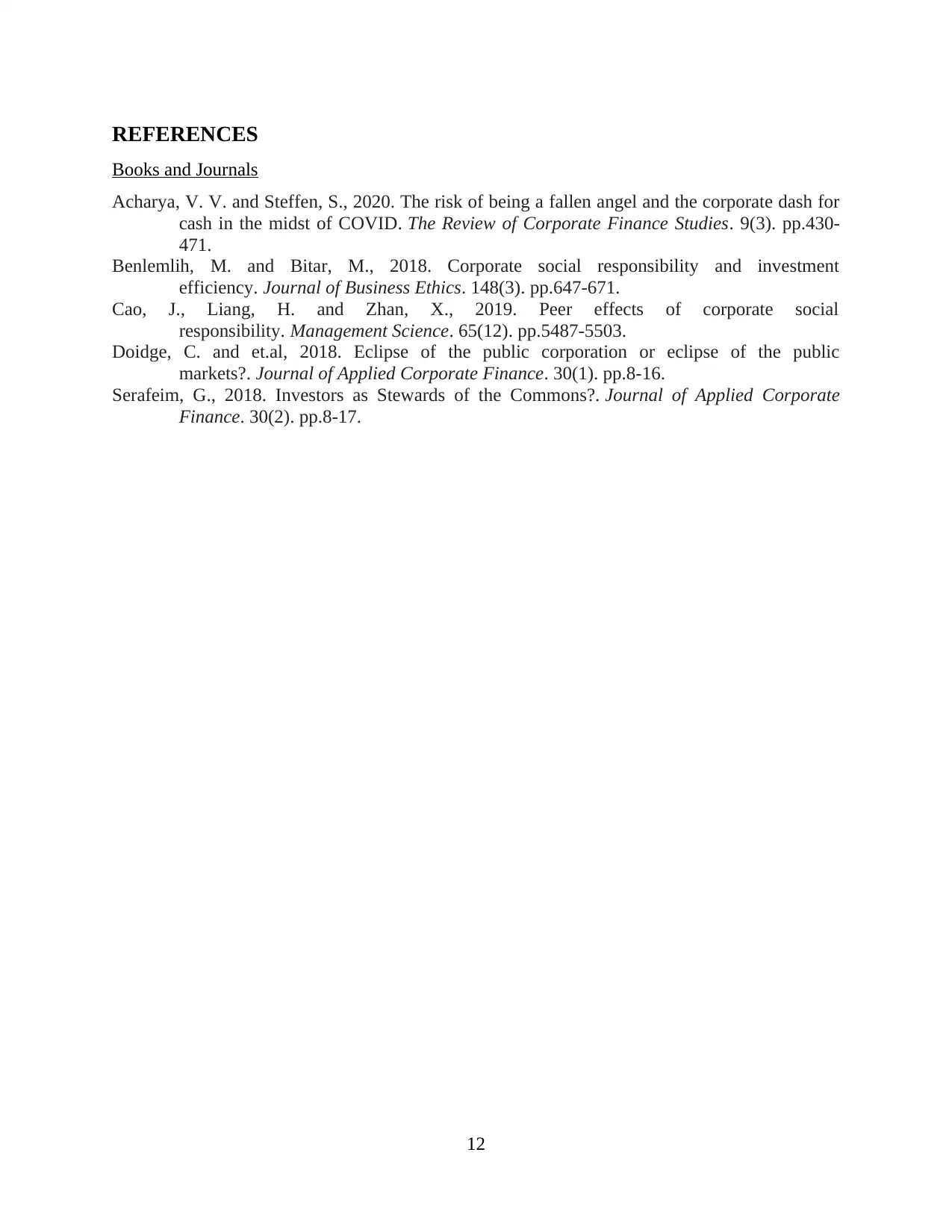
REFERENCES
Books and Journals
Acharya, V. V. and Steffen, S., 2020. The risk of being a fallen angel and the corporate dash for
cash in the midst of COVID. The Review of Corporate Finance Studies. 9(3). pp.430-
471.
Benlemlih, M. and Bitar, M., 2018. Corporate social responsibility and investment
efficiency. Journal of Business Ethics. 148(3). pp.647-671.
Cao, J., Liang, H. and Zhan, X., 2019. Peer effects of corporate social
responsibility. Management Science. 65(12). pp.5487-5503.
Doidge, C. and et.al, 2018. Eclipse of the public corporation or eclipse of the public
markets?. Journal of Applied Corporate Finance. 30(1). pp.8-16.
Serafeim, G., 2018. Investors as Stewards of the Commons?. Journal of Applied Corporate
Finance. 30(2). pp.8-17.
12
Books and Journals
Acharya, V. V. and Steffen, S., 2020. The risk of being a fallen angel and the corporate dash for
cash in the midst of COVID. The Review of Corporate Finance Studies. 9(3). pp.430-
471.
Benlemlih, M. and Bitar, M., 2018. Corporate social responsibility and investment
efficiency. Journal of Business Ethics. 148(3). pp.647-671.
Cao, J., Liang, H. and Zhan, X., 2019. Peer effects of corporate social
responsibility. Management Science. 65(12). pp.5487-5503.
Doidge, C. and et.al, 2018. Eclipse of the public corporation or eclipse of the public
markets?. Journal of Applied Corporate Finance. 30(1). pp.8-16.
Serafeim, G., 2018. Investors as Stewards of the Commons?. Journal of Applied Corporate
Finance. 30(2). pp.8-17.
12
1 out of 14
Your All-in-One AI-Powered Toolkit for Academic Success.
+13062052269
info@desklib.com
Available 24*7 on WhatsApp / Email
![[object Object]](/_next/static/media/star-bottom.7253800d.svg)
Unlock your academic potential
© 2024 | Zucol Services PVT LTD | All rights reserved.